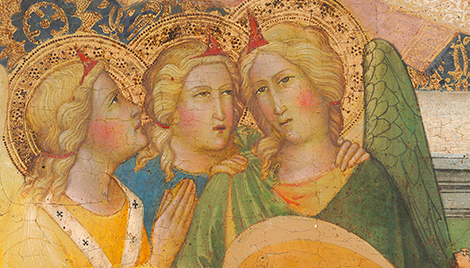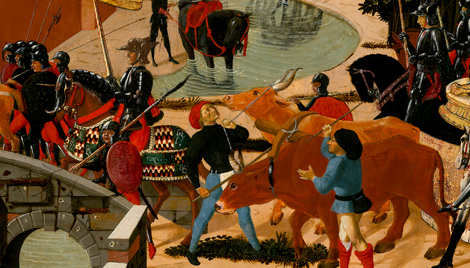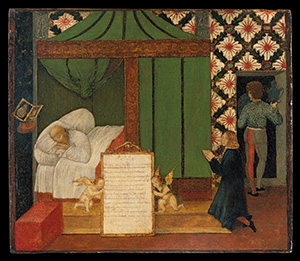Ex Voto
Ex Voto
- Artist
- Attributed to Gian Francesco de' Maineri
- Artist Dates
- active 1489/1506
- Artist Nationality
- Italian
- Title
- Ex Voto
- Date
- 1501-02
- Medium
- oil on panel
- Dimensions
- 28.6 x 32.4 cm (11-1/4 x 12-3/4 in)
- K Number
- K1182
- Repository
- Museum of Art and Archaeology
- Accession Number
- 61.8
- Notes
Provenance
Private Collection, Ferrara. (Count Alessandro Contini Bonacossi [1878-1955] Rome-Florence); sold to Samuel H. Kress [1863-1955] on 1 September 1939 as Gian Francesco de' Manieri; gift to the National Gallery of Art in 1943; deaccessioned 1952 and returned to the Samuel H. Kress Foundation; gift to Museum of Art and Archaeology, University of Missouri, no. 61.80.
Catalogue Entry
Attributed to Gian Francesco de' Maineri
Ex Voto
K1182
Columbia. Mo., University of Missouri. Study Collection (61.80). since 1961. Wood. 11 1/4 x 12 3/4 in. (28.6 x 32.4 cm.). Inscribed on the tablet in the foreground: A(nno) S(alutis) MDI Erravi fateor Par(c)as mi h(odi)erna precantem / Sol(o) det genitrix Virgo sopitus af(a)m(e)n / Ehiu planctu lacrimis gemitu precibus (que) superba / Hactenus in (ri)pam Nimpha pr(e)cata mihi est / Fatebar novi: dubio nam principe vite / Febre: semel suplex me ad tua vota tuli / Protinus auditis precibus pia Virgo: dedisti / Incolumem qui iam semisepultus erat / Quare age deducerit mea donee stamina Parce / Relliquiasque mei pulueris uma reget / Tu requies tranquilla mihi tu portus et aura / Principium medium semita finis eris(1). Abraded throughout. This small panel, dated by the inscription 1501, probably commemorates a vow offered up to the Virgin in supplication for the recovery of the old man in the bed. It is presumably his son who kneels in prayer at the foot of the bed while a servant leaves the room at the right. The emphasis upon ornament and the echo of Roberti's style in the earnest actors in the scene lend credence to the attribution of the miniaturelike painting to Maineri.(2) Provenance: Private Collection, Ferrara. Contini Bonacossi, Florence. Kress acquisition, 1939 –exhibited: National Gallery of Art, Washington,D.C. (523),1941-52.(3)
References
(1) For this transcription I am indebted to Professor Robert P. Sonkowsky, who notes that the first four lines, parts of which have been erased and rewritten, are somewhat fragmentary and considerably garbled. Professor Sonkowsky has also kindly suggested the following translation of the inscription: A.D. 1501 I have sinned, I confess. Have mercy on me. Let the Virgin Mother only grant the approach of sleep to me as I pray for daily things. Up to this point, on the shore, the proud Nymph, with oh lamentation, tears, groaning, and prayers, was prayed to by me. I confessed, I acknowledge: for when the foundation of my life wavered with fever, as soon as I came as a suppliant in prayer to Thee, hearing my prayers at once thou hast granted, Holy Virgin, safety to one who had already been half buried. Therefore, then, until the funeral urn spins out my threads of Destiny and rules over the remains of my dust, Thou shalt be my peaceful rest, my harbor and breeze, the beginning, the middle, the pathway, the end. (2) R. Longhi (Officina ferrarese, 1956, p. 153, and 1940 cd., p. 26), G. Fiocco, F. M. Perkins tentatively, W. E. Suida, and A. Venturi (in ms. opinions) attribute K1182 to Maineri; B. Berenson (in ms. opinion) calls it North Italian. (3) Preliminary Catalogue, 1941, p. 121, as Maineri.






